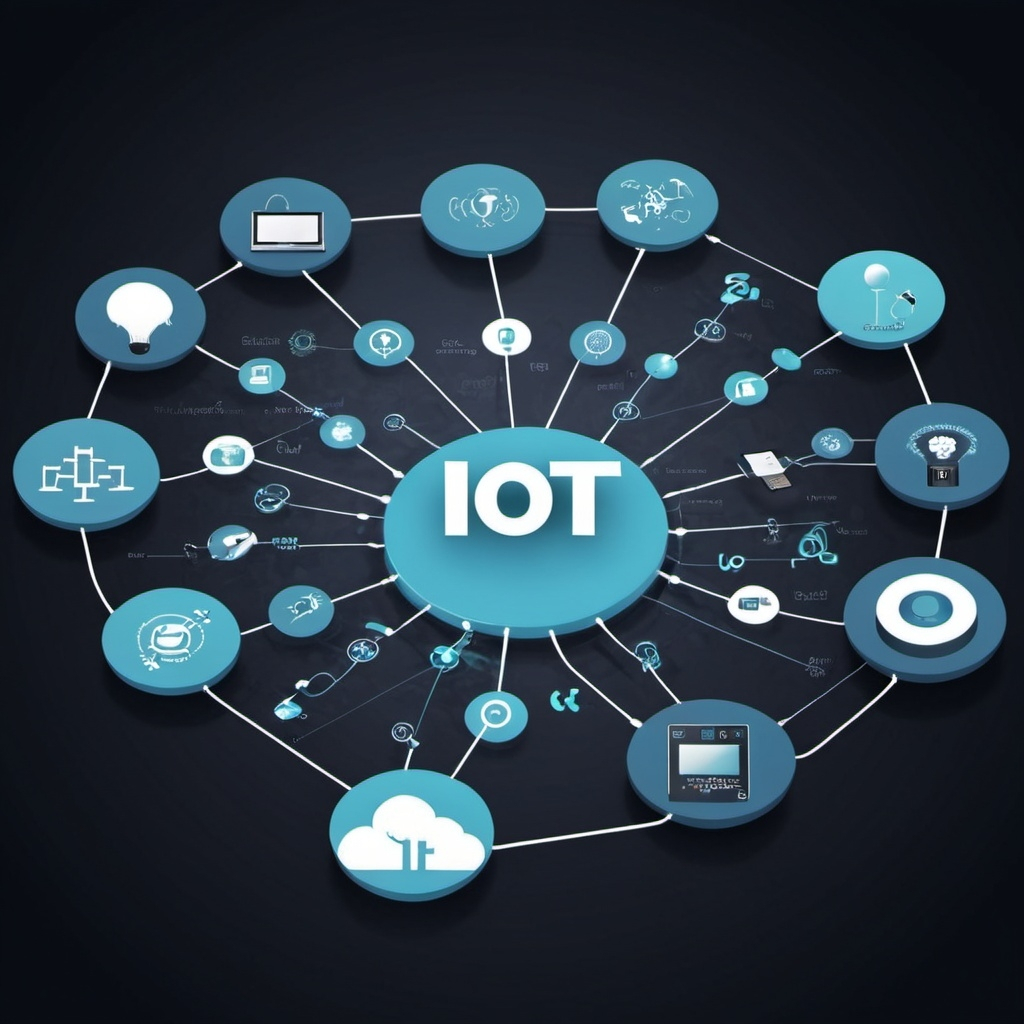A Comprehensive Overview and comparing it with UNL IoT Network
The Internet of Things (IoT) has revolutionized the way we interact with technology, offering an interconnected ecosystem where devices communicate and collaborate to improve efficiency and convenience. The ISU IoT Network stands out in this domain as a pioneering platform that embodies the essence of IoT, enabling seamless integration across diverse devices and applications. As IoT continues to evolve, the ISU IoT Network has emerged as a significant player, driving innovation and setting benchmarks for others to follow.
The concept of IoT has been around for decades, but its real-world application has gained momentum in recent years. With advancements in technology and the increasing demand for smart solutions, IoT networks like ISU have become indispensable. They offer robust infrastructure and reliable connectivity, facilitating the creation of smart cities, automated industries, and enhanced consumer experiences. The ISU IoT Network, in particular, is designed to support a wide range of applications, from industrial automation to smart home solutions, providing a flexible and scalable platform for various IoT initiatives.
In this article, we will delve into the details of the ISU IoT Network, exploring its architecture, capabilities, and how it compares to other similar technologies. We will also trace its history, examining how it has evolved over time to meet the growing demands of the IoT ecosystem. By the end of this comprehensive overview, you will have a deeper understanding of what makes the ISU IoT Network a critical component of the modern IoT landscape.
Understanding ISU IoT Network
The ISU IoT Network is a sophisticated and comprehensive platform designed to provide seamless connectivity and interoperability among various IoT devices. It serves as a backbone for IoT deployments, offering a scalable, secure, and efficient infrastructure that supports a wide range of applications. The network is built on cutting-edge technology, incorporating the latest advancements in communication protocols, data management, and security measures.

Architecture of ISU IoT Network
The architecture of the ISU IoT Network is based on a multi-layered approach, ensuring robust connectivity and efficient data flow across different devices and applications. The core components of the ISU IoT Network architecture include:
- Device Layer: This layer comprises various IoT devices, sensors, and actuators that collect and transmit data. These devices are equipped with communication modules that enable them to connect to the ISU IoT Network.
- Network Layer: The network layer is responsible for managing the communication between devices and the central server. It includes various communication protocols such as Wi-Fi, Bluetooth, Zigbee, and cellular networks that facilitate seamless data transfer.
- Data Management Layer: This layer handles the storage, processing, and analysis of the data collected by IoT devices. It includes databases, data analytics tools, and machine learning algorithms that extract valuable insights from the data.
- Application Layer: The application layer is where the processed data is used to create meaningful applications. This could include smart home systems, industrial automation, health monitoring, and more.
- Security Layer: Security is a critical component of the ISU IoT Network. This layer includes various security protocols, encryption methods, and authentication mechanisms to ensure that the data transmitted and stored within the network is secure.
Key Features of ISU IoT Network
The ISU IoT Network offers several key features that make it stand out in the crowded IoT market:
- Scalability: The network is designed to support a large number of devices, making it ideal for large-scale IoT deployments. Whether it’s a smart city project or a massive industrial automation setup, the ISU IoT Network can handle it.
- Interoperability: One of the biggest challenges in IoT is ensuring that devices from different manufacturers can work together seamlessly. The ISU IoT Network addresses this by supporting a wide range of communication protocols and standards.
- Security: With the increasing number of cyber threats, security has become a top priority in IoT networks. The ISU IoT Network incorporates advanced security measures to protect the data and ensure the privacy of users.
- Data Analytics: The network is equipped with powerful data analytics tools that allow users to gain insights from the data collected by their IoT devices. This can be used to improve efficiency, reduce costs, and make better decisions.
- Low Latency: The ISU IoT Network is designed to provide low-latency communication, which is crucial for applications that require real-time data processing, such as autonomous vehicles and industrial automation.

Applications of ISU IoT Network
The versatility of the ISU IoT Network allows it to be used in a wide range of applications:
- Smart Cities: The ISU IoT Network can be used to create smart city solutions that improve the quality of life for residents. This includes smart traffic management, waste management, energy efficiency, and public safety systems.
- Industrial Automation: In the industrial sector, the ISU IoT Network can be used to automate processes, monitor equipment, and improve operational efficiency. This leads to reduced downtime, lower maintenance costs, and increased productivity.
- Healthcare: The ISU IoT Network can be used in healthcare to monitor patients’ health in real-time, track the use of medical equipment, and ensure the safety and security of patient data.
- Agriculture: In agriculture, the ISU IoT Network can be used to monitor soil conditions, track the growth of crops, and manage the use of resources such as water and fertilizers.
- Smart Homes: The ISU IoT Network can be used to create smart home systems that improve convenience and security for homeowners. This includes smart lighting, climate control, security systems, and more.
Brief History of ISU IoT Network
The development of the ISU IoT Network can be traced back to the early days of IoT technology. As the concept of IoT began to gain traction, there was a growing need for a robust and reliable network that could support the increasing number of IoT devices. In response to this demand, a group of researchers and engineers at ISU (Innovative Solutions Unlimited) began working on a new IoT network that would address the limitations of existing networks.
The initial development phase focused on creating a scalable and secure network architecture that could support a wide range of applications. The team also worked on developing new communication protocols that would enable seamless connectivity between devices from different manufacturers. After several years of research and development, the first version of the ISU IoT Network was launched.
Over the years, the ISU IoT Network has undergone several upgrades and improvements. Each new version introduced new features and capabilities, making it one of the most advanced IoT networks available today. The network has also been adopted by a wide range of industries, from healthcare and agriculture to manufacturing and smart cities.
Milestones in the Development of ISU IoT Network
- Initial Concept and Development: The concept for the ISU IoT Network was first developed in the early 2000s, as the demand for IoT solutions began to grow. The initial focus was on creating a network that could support a large number of devices while ensuring secure and reliable communication.
- First Version Launch: The first version of the ISU IoT Network was launched in the mid-2000s. It included basic features such as device connectivity, data management, and security protocols.
- Introduction of Advanced Features: Over the next few years, the ISU IoT Network underwent several upgrades, introducing advanced features such as data analytics, machine learning, and support for new communication protocols.
- Expansion into New Industries: As the capabilities of the ISU IoT Network expanded, it began to be adopted by new industries, including healthcare, agriculture, and manufacturing.
- Global Adoption: Today, the ISU IoT Network is used by organizations around the world, making it one of the most widely adopted IoT networks.
Comparative Analysis of ISU IoT Network with Similar Technologies
The ISU IoT Network stands out in the IoT landscape, but it is important to compare it with other similar technologies to understand its unique position.

The following table compares the ISU IoT Network with other popular IoT networks:
| Feature | ISU IoT Network | AWS IoT Core | Google Cloud IoT | Microsoft Azure IoT |
|---|---|---|---|---|
| Scalability | High | High | High | High |
| Interoperability | Supports multiple protocols | Limited to AWS services | Supports multiple protocols | Limited to Azure services |
| Security | Advanced, multi-layered | Advanced, cloud-based | Advanced, cloud-based | Advanced, cloud-based |
| Data Analytics | Built-in, with machine learning | AWS Analytics | Google Analytics | Azure Analytics |
| Application Areas | Wide range | Focused on cloud applications | Focused on cloud applications | Focused on cloud applications |
| Latency | Low | Moderate | Moderate | Moderate |
| Ease of Integration | High | Moderate | Moderate | Moderate |
| Customization | High | Limited to AWS tools | Limited to Google tools | Limited to Azure tools |
Analysis of the Comparison
- Scalability: All four networks, including ISU IoT Network, offer high scalability, which is crucial for large-scale IoT deployments.
- Interoperability: The ISU IoT Network excels in interoperability, supporting a wide range of communication protocols, making it versatile across different industries. In contrast, AWS IoT Core, Google Cloud IoT, and Microsoft Azure IoT have limited interoperability, often being optimized for their respective ecosystems. This makes the ISU IoT Network more adaptable for diverse applications, particularly in environments where devices from multiple manufacturers need to work together seamlessly.
- Security: While all four platforms provide advanced security features, the ISU IoT Network’s multi-layered security approach stands out. Its emphasis on end-to-end encryption, secure device authentication, and real-time threat detection offers a comprehensive security framework that is crucial in industries like healthcare and industrial automation, where data breaches can have serious consequences.
- Data Analytics: Data analytics is a key feature for deriving value from IoT data. The ISU IoT Network includes built-in data analytics capabilities, including machine learning algorithms, which are particularly useful for predictive maintenance, real-time decision-making, and optimizing operations. AWS, Google Cloud, and Microsoft Azure also offer powerful analytics tools, but these are typically more tightly integrated with their respective cloud services, which may limit flexibility for some users.
- Application Areas: The ISU IoT Network is designed to be versatile, supporting a wide range of applications across different industries. This contrasts with AWS IoT Core, Google Cloud IoT, and Microsoft Azure IoT, which are more focused on cloud-centric applications, making them highly effective for enterprises already invested in those ecosystems but potentially less adaptable for broader use cases.
- Latency: Low latency is critical for applications that require real-time data processing, such as autonomous vehicles, industrial automation, and critical healthcare monitoring. The ISU IoT Network’s architecture is optimized to minimize latency, providing a performance edge over its cloud-based competitors, which may experience higher latency due to the inherent delays in cloud communication.
- Ease of Integration: The ISU IoT Network offers high ease of integration, supporting a broad range of devices and communication protocols without locking users into a specific ecosystem. This contrasts with the other platforms, which are designed to work best within their cloud environments. For businesses looking to integrate IoT with existing infrastructure or across multiple vendors, the ISU IoT Network offers greater flexibility.
- Customization: The ISU IoT Network is highly customizable, allowing users to tailor the network to their specific needs. This is particularly valuable in industries where bespoke solutions are required. On the other hand, while AWS, Google, and Microsoft offer customization options, they are often limited to the tools and services provided within their platforms, which can be restrictive for certain applications.
Key Developments and Upgrades of the ISU IoT Network
The evolution of the ISU IoT Network has been marked by several key developments and upgrades that have expanded its capabilities and solidified its position as a leading IoT platform.
- Integration with AI and Machine Learning: One of the significant upgrades to the ISU IoT Network was the integration of AI and machine learning capabilities. This allows the network to not only process and analyze data but also to predict outcomes and optimize processes automatically. This integration is particularly beneficial in applications such as predictive maintenance in manufacturing, where machine learning algorithms can forecast equipment failures before they occur.
- Enhanced Security Features: Recognizing the growing threat of cyberattacks, ISU has continually enhanced the security features of its IoT network. Recent updates have introduced real-time threat detection, automated incident response, and advanced encryption protocols. These enhancements are designed to protect against the latest cybersecurity threats, ensuring that the network remains secure even as new vulnerabilities are discovered.
- Support for Edge Computing: As IoT deployments have grown in scale and complexity, there has been an increasing demand for edge computing solutions. The ISU IoT Network has responded to this demand by integrating edge computing capabilities, allowing data to be processed closer to the source. This reduces latency, improves response times, and reduces the load on central servers. This is especially important in scenarios where real-time data processing is critical, such as in autonomous vehicles or remote healthcare monitoring.
- Expansion of Communication Protocols: To ensure broad compatibility and interoperability, the ISU IoT Network has expanded its support for various communication protocols, including emerging standards like LoRaWAN and 5G. This expansion enables the network to connect with a wider range of devices and applications, making it more versatile and future-proof.
- Partnerships and Ecosystem Expansion: ISU has formed strategic partnerships with leading technology companies, expanding its ecosystem and enabling deeper integration with other technologies. These partnerships have allowed the ISU IoT Network to offer enhanced capabilities, such as better cloud integration, advanced analytics, and more robust device management.
The Future of ISU IoT Network
As the IoT landscape continues to evolve, the ISU IoT Network is poised to play a crucial role in shaping the future of connected devices and smart technologies. Several trends and developments are expected to influence the direction of the ISU IoT Network in the coming years:
- Increased Adoption of 5G: With the rollout of 5G networks worldwide, the ISU IoT Network is expected to leverage the enhanced speed, capacity, and reliability of 5G to support more devices and enable new applications. The combination of 5G and IoT is likely to drive significant advancements in areas such as smart cities, autonomous vehicles, and industrial automation.
- Greater Focus on Sustainability: As environmental concerns become more pressing, there is a growing emphasis on using IoT to promote sustainability. The ISU IoT Network is likely to play a key role in this effort, enabling more efficient use of resources, reducing waste, and supporting the development of green technologies.
- Advancements in AI and Machine Learning: The integration of AI and machine learning into IoT networks is expected to continue, with the ISU IoT Network at the forefront of these developments. Future enhancements are likely to include more sophisticated algorithms, real-time decision-making capabilities, and greater automation, further increasing the value of IoT deployments.
- Expansion into New Industries: While the ISU IoT Network is already used in a wide range of industries, there is potential for further expansion into new areas, such as renewable energy, transportation, and education. As IoT technology becomes more pervasive, the ISU IoT Network is well-positioned to support the needs of these emerging sectors.
- Enhanced User Experience: As IoT technology matures, there is a growing demand for more user-friendly interfaces and tools that make it easier to manage and analyze IoT data. The ISU IoT Network is expected to continue improving its user interface, making it more intuitive and accessible for users with varying levels of technical expertise.
UNL IoT Network: An Overview
There are many IoT networks and UNL is one of them. The UNL IoT Network (Universal Network Layer for the Internet of Things) is a relatively new player in the IoT space, designed to provide a comprehensive and adaptable framework for connecting and managing IoT devices across diverse environments. It aims to address some of the key challenges faced by IoT networks, such as scalability, interoperability, and security, by offering a standardized approach to IoT communication and data management.

Key Features of UNL IoT Network
- Standardized Communication Protocols: The UNL IoT Network utilizes standardized communication protocols to ensure seamless interoperability among devices from different manufacturers. This approach simplifies integration and reduces the complexity of managing diverse IoT ecosystems.
- Scalability: Designed to support a large number of IoT devices, the UNL IoT Network provides a scalable architecture that can handle extensive deployments, from smart cities to industrial applications.
- Enhanced Security: Security is a primary focus of the UNL IoT Network. It incorporates advanced security measures, including encryption, authentication, and access control, to protect data and maintain the integrity of the network.
- Data Management: The network includes robust data management tools for collecting, storing, and analyzing data generated by IoT devices. This allows for real-time data processing and actionable insights.
- Flexibility: The UNL IoT Network is designed to be adaptable, supporting various communication technologies and protocols to meet the specific needs of different applications.
Comparative Analysis: UNL IoT Network vs. ISU IoT Network
To understand how the UNL IoT Network compares to the ISU IoT Network, let’s look at some of the key aspects and differences between the two:
| Feature | UNL IoT Network | ISU IoT Network |
|---|---|---|
| Scalability | High | High |
| Interoperability | Standardized protocols | Supports multiple protocols |
| Security | Advanced, standardized | Advanced, multi-layered |
| Data Management | Robust, integrated | Built-in analytics, machine learning |
| Flexibility | High | High |
| Application Areas | Wide range | Wide range, with focus on specific industries |
| Latency | Low | Low |
| Ease of Integration | High | High |
| Customization | Moderate | High |
1. Scalability
Both the UNL and ISU IoT Networks offer high scalability, supporting extensive deployments with numerous devices. Their architectures are designed to handle large-scale IoT environments effectively.
2. Interoperability
The UNL IoT Network emphasizes standardized communication protocols, which can simplify integration and ensure compatibility across different devices and systems. In contrast, the ISU IoT Network supports multiple communication protocols, offering flexibility but potentially requiring more complex integration processes.
3. Security
The UNL IoT Network employs advanced, standardized security measures to protect data and network integrity. The ISU IoT Network also incorporates robust security features, with a multi-layered approach that includes encryption, authentication, and real-time threat detection. Both networks prioritize security but approach it with different strategies.
4. Data Management
The UNL IoT Network offers integrated data management tools for processing and analyzing data from IoT devices. The ISU IoT Network includes built-in analytics and machine learning capabilities, providing more advanced data analysis features directly within the network.
5. Flexibility
Both networks are designed to be flexible, supporting a variety of communication technologies and protocols. The UNL IoT Network focuses on standardization, while the ISU IoT Network offers broad compatibility with different protocols, which can be advantageous for specific use cases.
6. Application Areas
Both networks are versatile and can be used across a wide range of applications. The ISU IoT Network has a strong presence in specific industries like healthcare, manufacturing, and smart cities, while the UNL IoT Network aims to provide a broad framework applicable to various sectors.
7. Latency
Both networks are optimized for low latency, making them suitable for real-time data processing applications. This is crucial for applications requiring immediate responses, such as autonomous vehicles or industrial automation.
8. Ease of Integration
The UNL IoT Network and ISU IoT Network both offer high ease of integration, though the UNL IoT Network’s standardized approach may simplify the process for certain applications. The ISU IoT Network provides flexibility in integrating with various devices and systems.
9. Customization
The ISU IoT Network allows for higher levels of customization, making it suitable for tailored solutions in specific industries. The UNL IoT Network offers moderate customization, focusing on standardized solutions that cater to a broad range of applications.
The UNL IoT Network and the ISU IoT Network each have their strengths and are designed to address different needs within the IoT ecosystem. The UNL IoT Network emphasizes standardization and integration simplicity, making it suitable for a wide range of applications with a focus on standardized protocols and advanced security measures. The ISU IoT Network offers high flexibility, advanced data analytics, and robust security features, making it a strong choice for specific industries and applications requiring high customization.
Both networks provide scalable, secure, and low-latency solutions for IoT deployments. The choice between the two will depend on factors such as the need for standardized protocols, the level of customization required, and the specific application areas being targeted.
Conclusion
The ISU IoT Network represents a significant advancement in the field of IoT, offering a comprehensive and versatile platform that supports a wide range of applications across different industries. Its robust architecture, advanced features, and strong focus on security make it a leading choice for organizations looking to deploy IoT solutions at scale.
Over the years, the ISU IoT Network has continually evolved to meet the growing demands of the IoT ecosystem, incorporating the latest advancements in technology and expanding its capabilities. As IoT continues to evolve, the ISU IoT Network is poised to remain at the forefront of this transformation, driving innovation and enabling new possibilities in the world of connected devices.
The comparative analysis with other similar technologies highlights the unique strengths of the ISU IoT Network, particularly in terms of interoperability, security, and low latency. These attributes, combined with its ability to integrate seamlessly with other technologies and its commitment to future-proofing, make the ISU IoT Network a critical component of the modern IoT landscape.
As we look to the future, the ISU IoT Network is expected to play an increasingly important role in shaping the next generation of IoT solutions, driving advancements in areas such as 5G, AI, and sustainability. For businesses and organizations looking to harness the power of IoT, the ISU IoT Network offers a reliable, scalable, and secure platform that can meet the demands of today and tomorrow.
Curated Reads:





There is definately a lot to find out about this subject. I like all the points you made